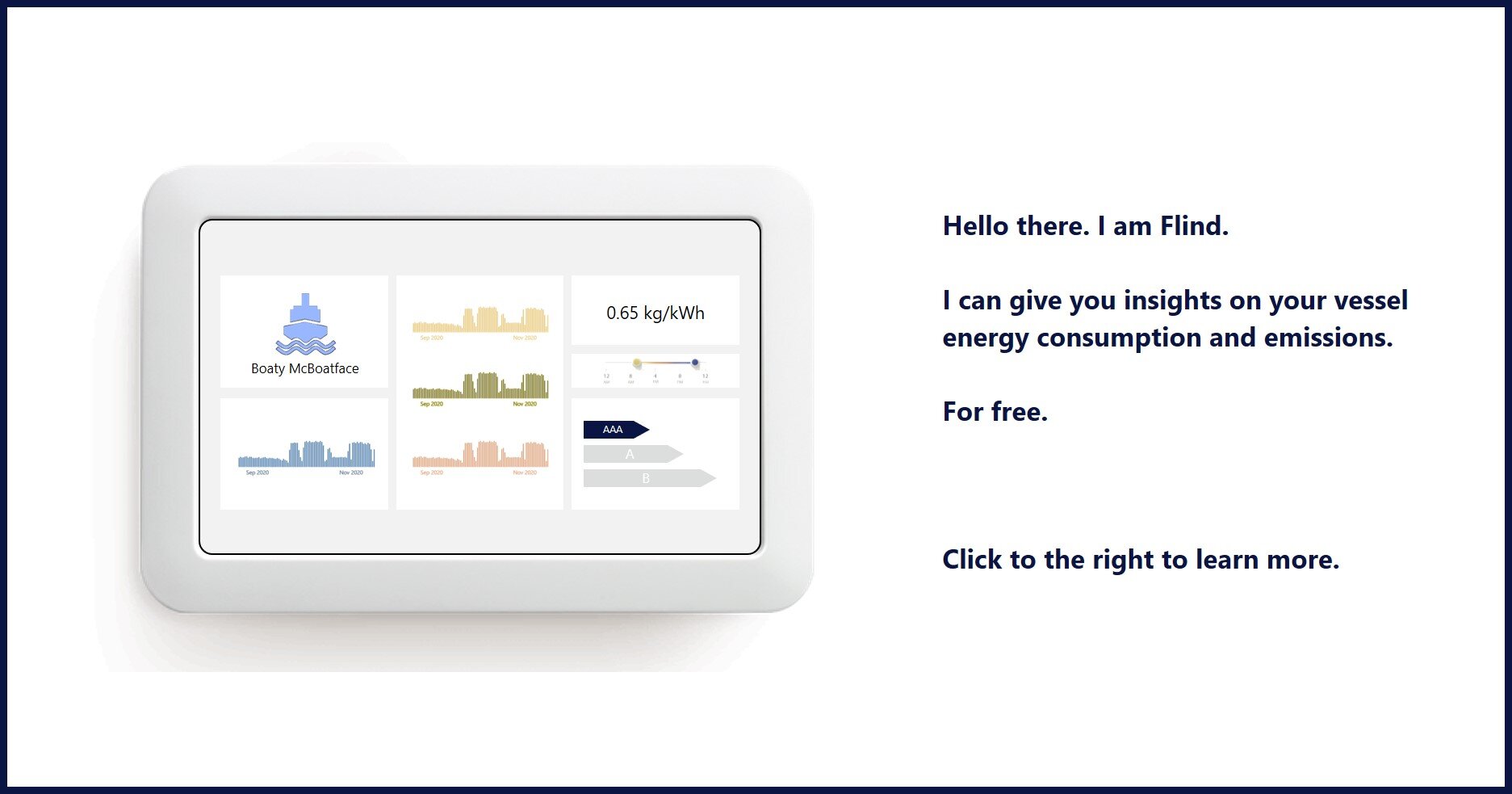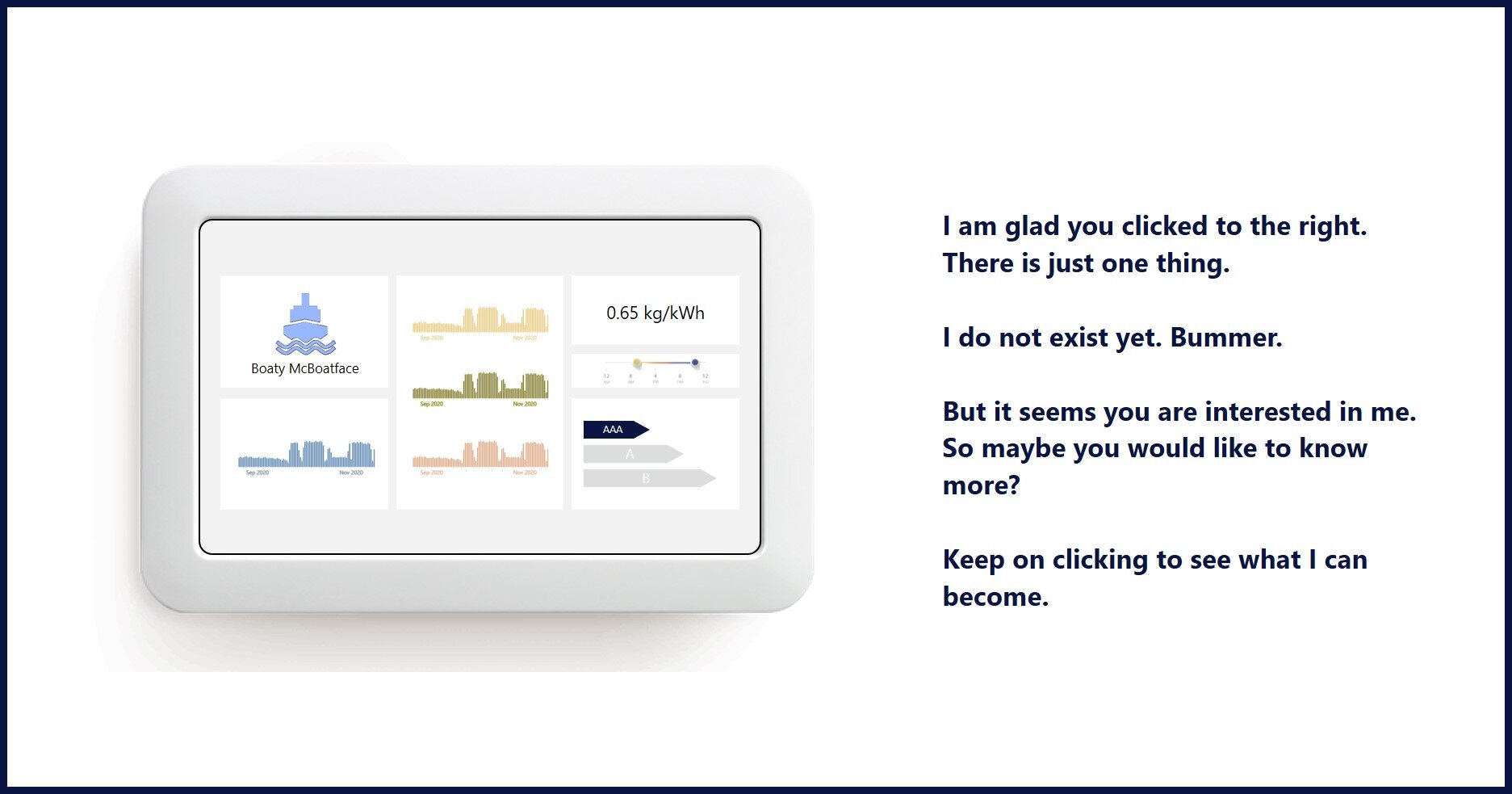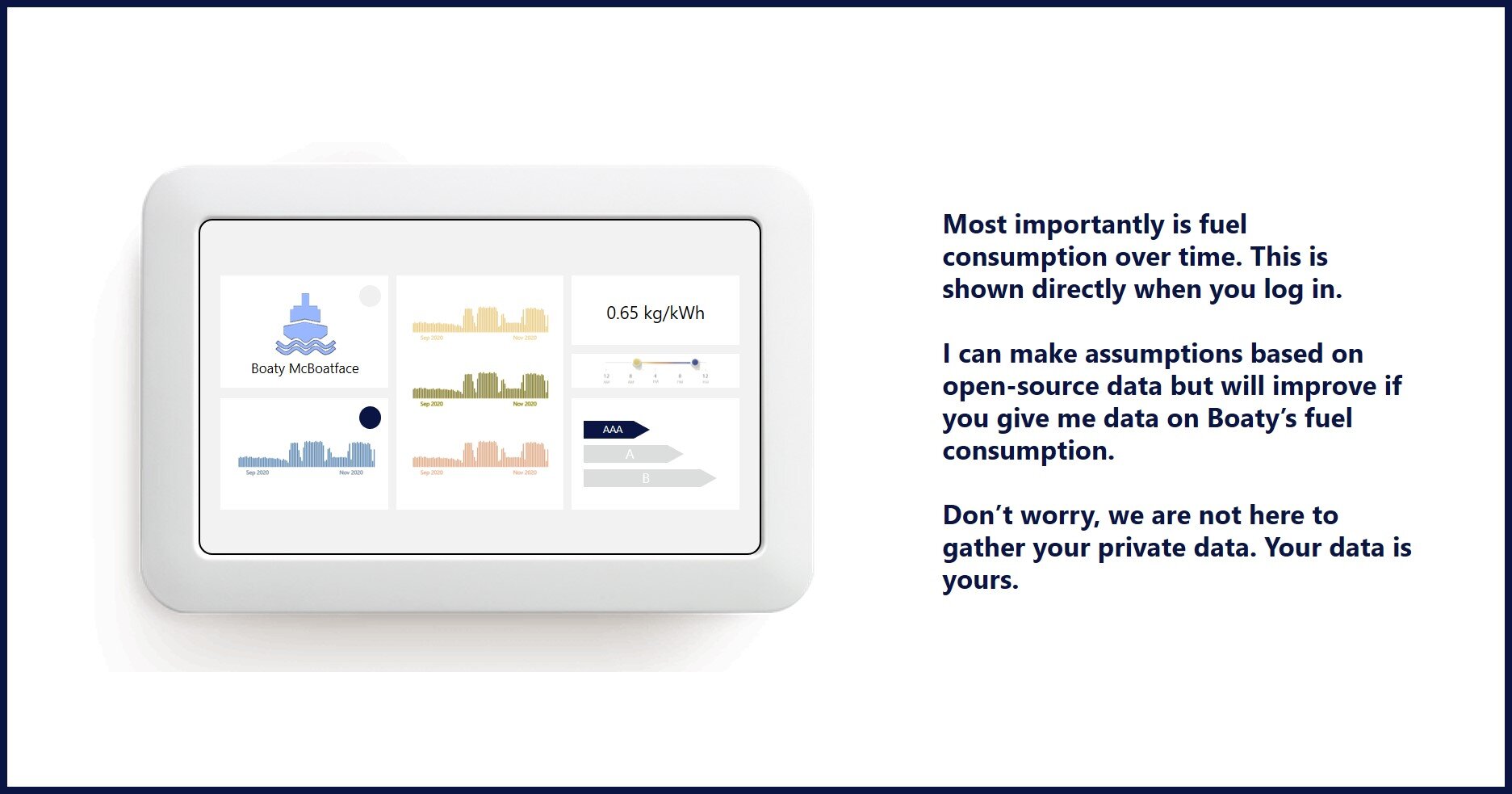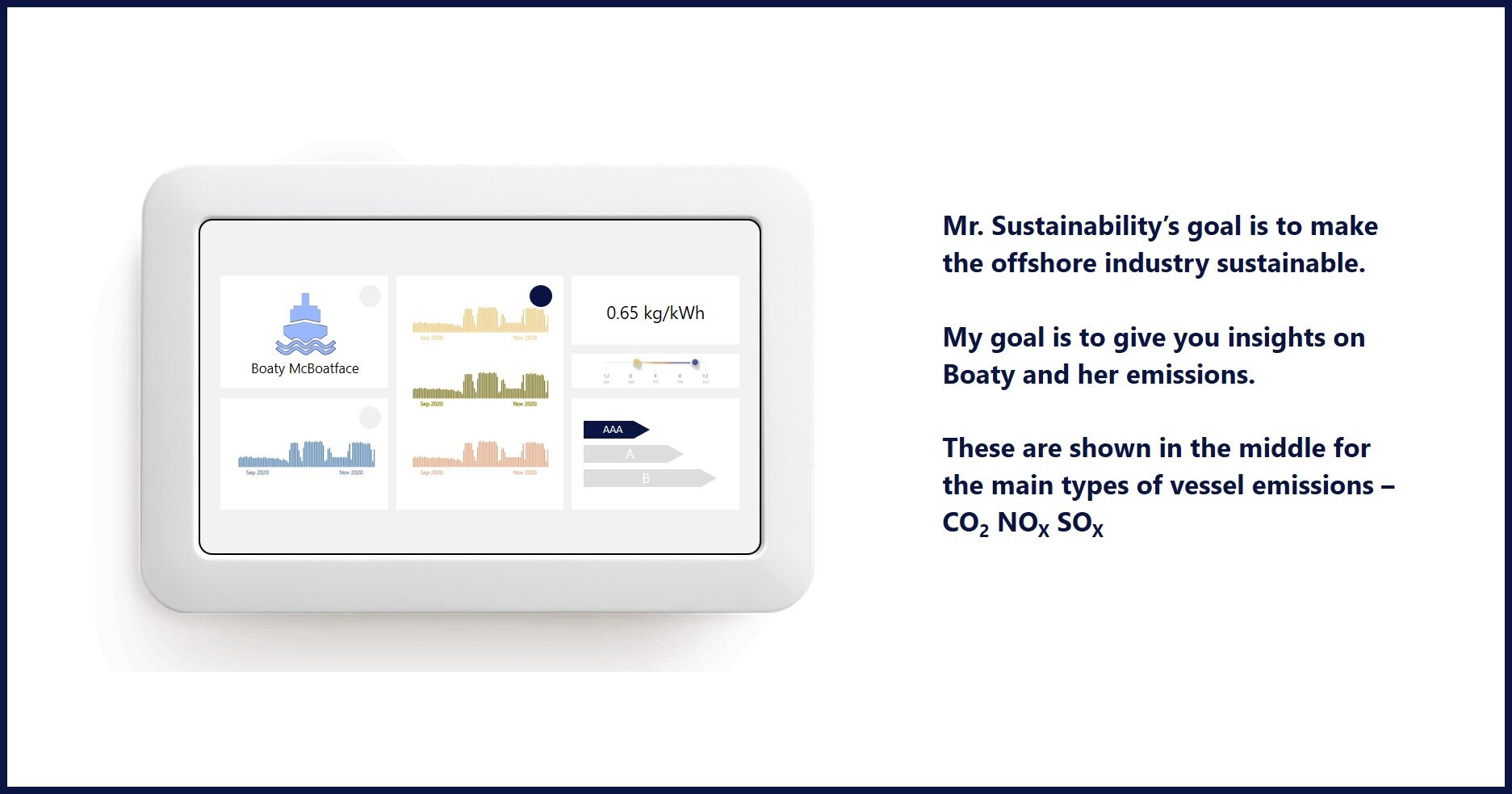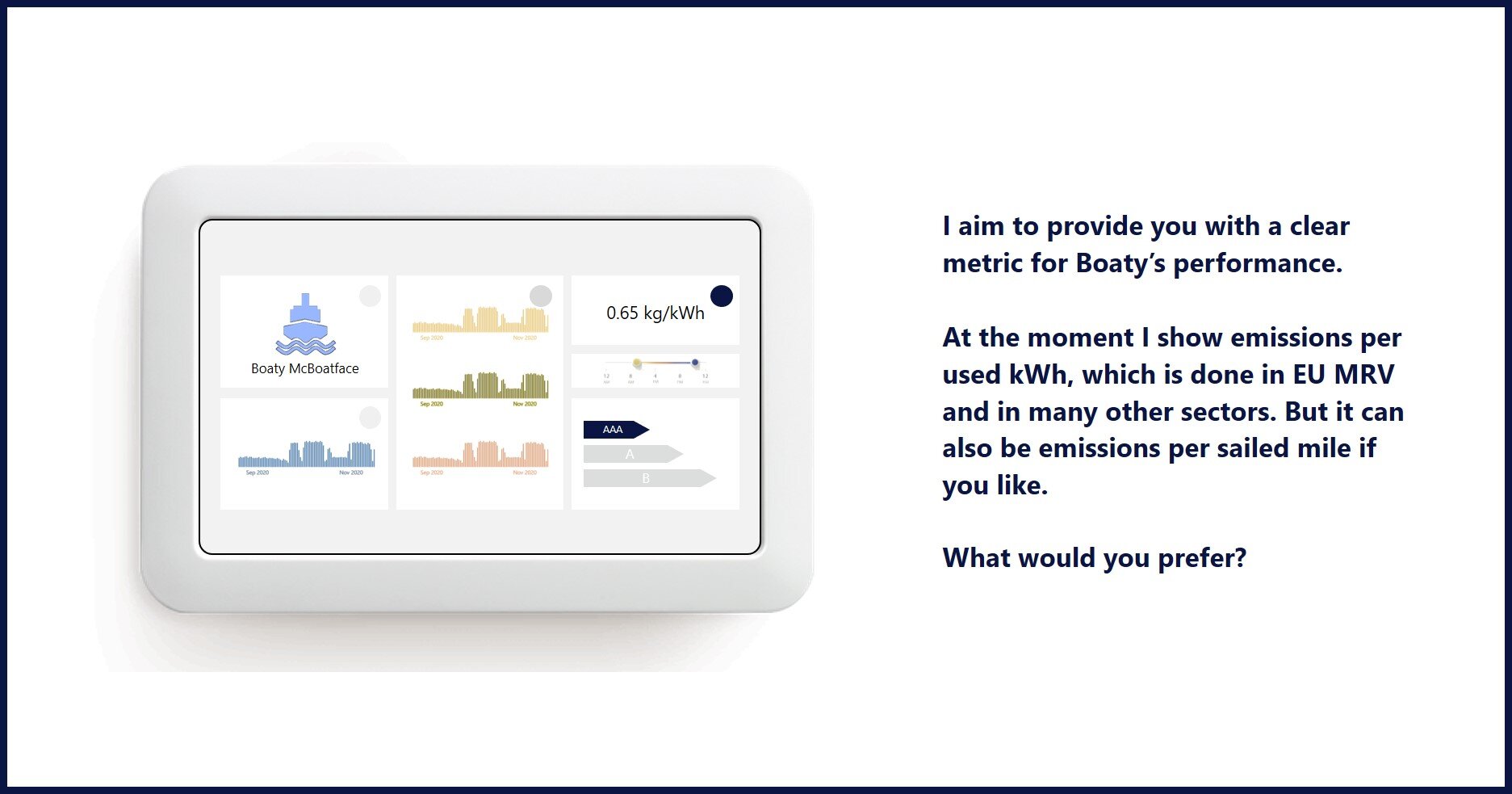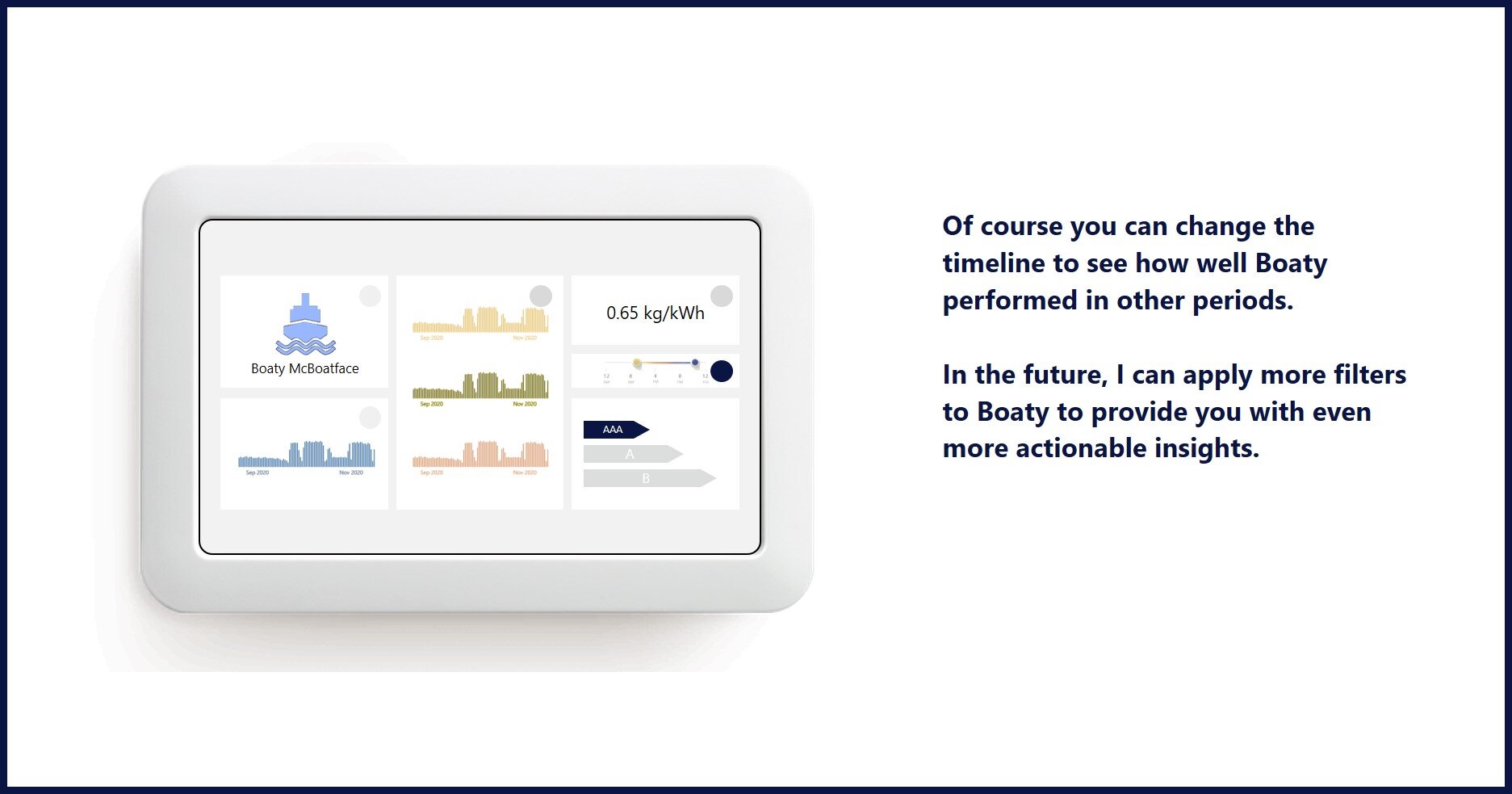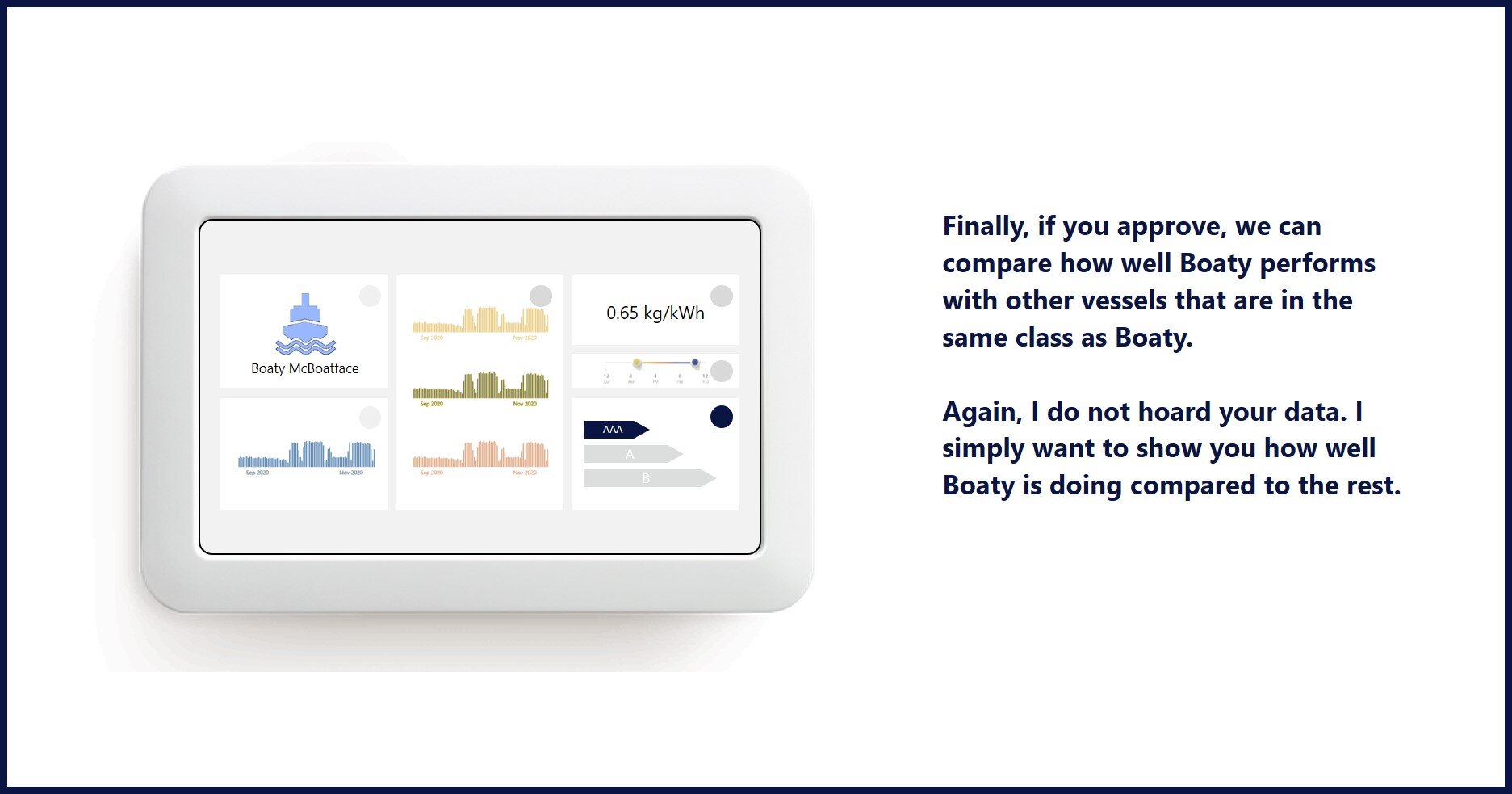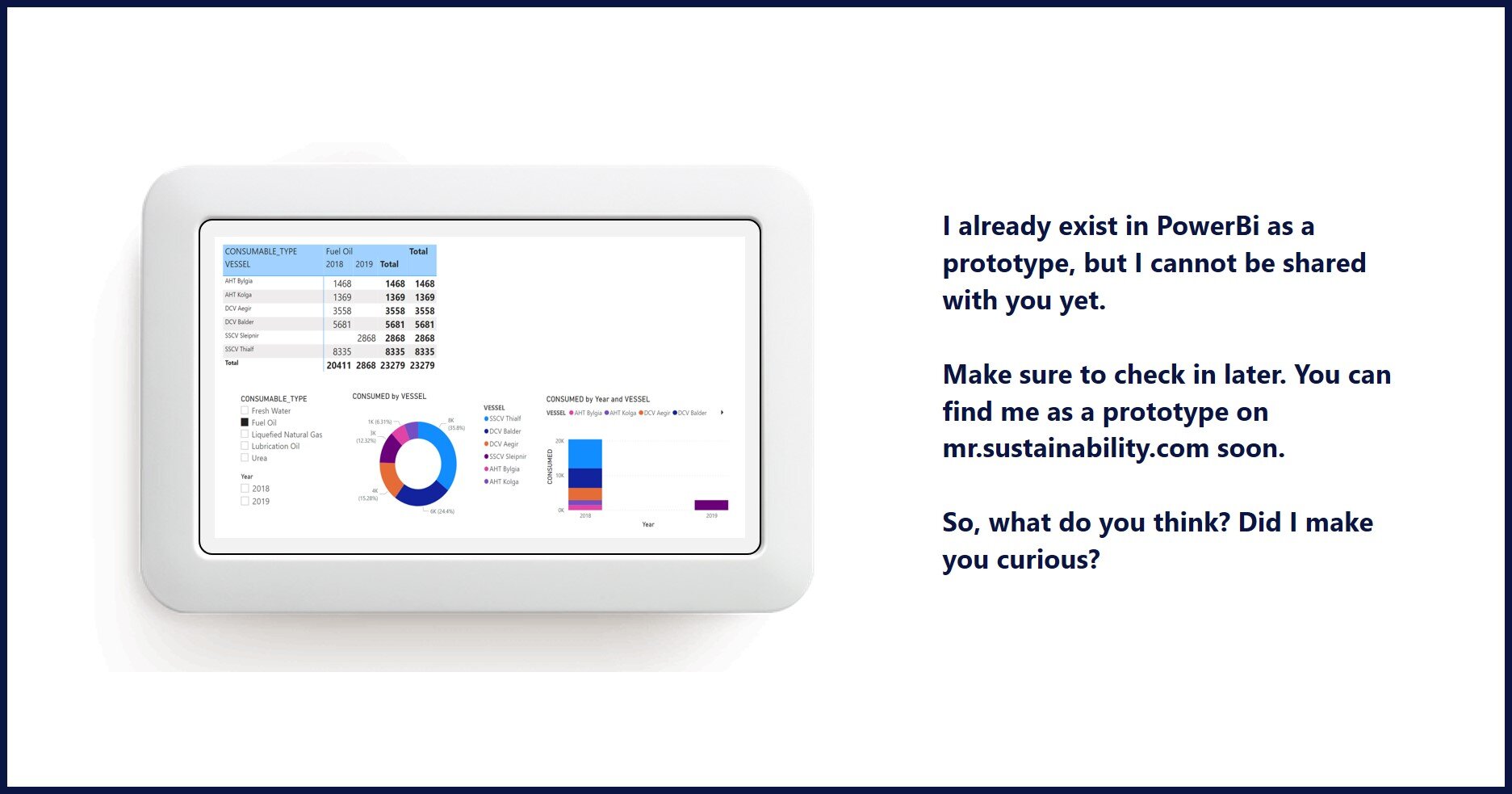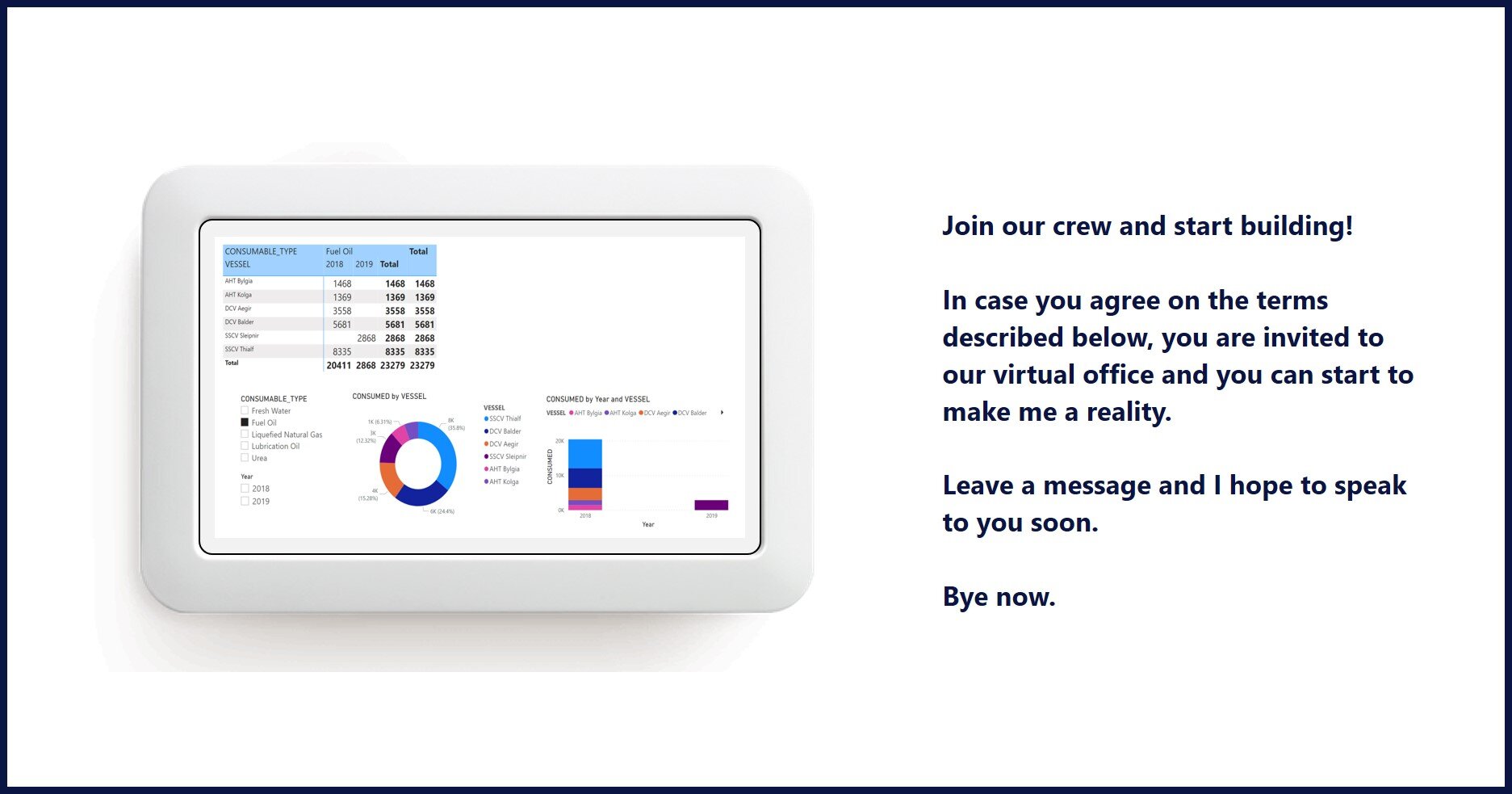Meet Flind
Flind is a dashboard that gives you insights on your vessel’s energy consumption and emissions. For free.
Summary - We all know that the maritime world is transforming. The US is calling for shipping to have zero emissions by 2050. If you are reading this, chances are you work in the maritime industry and you are frustrated. Of course you want to reduce emissions, but how? Perhaps Flind could help.
Flind is a dashboard that gives you free insights on your vessel energy consumption and emissions. It helps you to determine what you can do to decarbonize, how you can do this, and how much it would cost. All for free. Why? Because we want to make the maritime industry sustainable, and believe everyone deserves their vessel insights for free.
Do you only have 2 minutes? Click through the gallery below to learn more about Flind and how it works. Do you have more time and love to read? Check out the rest of this blog.
In case we have peaked your interest and you would like to contribute to Flind, leave a comment below. Perhaps you can be one of the lucky few to start building Flind, today.
The Great Maritime Transformation
The maritime industry is facing a great transformation. Ship emissions need to be reduced significantly. The International Maritime Organization is striving for at least 50% reduction of greenhouse gasses by 2050. The US is calling for shipping to have zero emissions by 2050. Though it can be - and is very much - debated how fast this can be achieved, one thing is certain. We will not be sailing the seas in the same way by 2050 as we do now. We need to change.
Bummer.
How can we change?
If you are reading this, chances are you are working in the maritime industry and you are frustrated.
Of course we want to become more sustainable as an industry, even though it is allegedly cleaner than aviation or road transport. Of course you want to reduce your vessel emissions. Less emissions means less fuel, which means reduced costs.
But what can you do? How can you do this? And perhaps more importantly, how much does it cost to decarbonize your vessel?
What is shared ‘on the internet’ or by other organizations is too generic, not applicable to your vessel or too expensive to investigate. Many organizations do not have fancy sustainability advisors who can make a roadmap for your vessel to decarbonize. You are busy and need to focus on the work at hand. Still, you want to become more sustainable, your clients want you to be more sustainable, and (young) employees are demanding you to become more sustainable. In short, everyone wants to become sustainable, but not everybody knows how to do it.
How do we fix this?
Meet Flind
Flind - Floating Insights Dashboard - gives you insights on your vessel’s energy consumption and emissions. Based on open-source data like MarineTraffic and Thetis, an overview on your fuel consumption and accompanying emissions is provided. In case you want to improve the data, you can input your ships logs or daily progress reports and you can see exactly what you emit on a daily basis or more.
Based on this data, you determine what you want do to decrease emissions. Or not, in the case you are already best in class! You can use this information for your Ship Energy Efficiency Management Plan, or simply as a guide to become more sustainable. All for free.
> Example with Boaty McBoatface
Let’s take Boaty McBoatface as an example, Boaty in short. Boaty is a lovely crane vessel that works and operates around the world. Sometimes it is hard for the crew and the people back in the office to watch fuel consumption closely. There is no dashboard available that provides clear insights in energy consumption and emissions. In comes Flind.
When Boaty is typed into Flind’s opening screen, the first thing they see is a dashboard with insights based on open-source data. This is a good first step, but there is more detailed data available. Boaty’s logs are uploaded and detailed insights emerge. Based on the information provided, Flind can make a custum-made report for Boaty, telling her she could use a battery to reduce her energy consumption, or which biofuels she can use based on where she has been sailing in the world. This makes Boaty and her crew very happy!
> What about Boaty’s private data?
Don’t worry, we are not here to gather your private data and sell it to the highest bidder. Your data is yours. We are simply here to transform your data and give you insights on what you can do to decarbonize, or guide you on how to do it. We work with open-source solutions because we believe that is the best way to make the offshore industry sustainable.
What can Flind do for you?
Flind is a free dashboard that gives you an overview of your energy consumption and emissions. It helps you to determine what you can do to decarbonize, how you can do this, and how much it would roughly cost you.
When you use Flind, he can check - all with discrete use of your data of course - how well you do in your vessel class compared to others. This helps you to determine if you are doing great, or if you need to put some more effort into it.
In addition, you can choose to connect to a community of fellow shipowners who all need to decarbonize. Everyone who works with Flind can ask questions on Mr. Communability, the community dedicated to make the offshore industry sustainable.
By now you must be wondering. Wait a minute, does this not already exist?
Are there not many other emissions insight dashboards like Flind?
Yes there are. You have probably seen other Flind’s before. DNV has their own emissions insights dashboard. Kongsberg has Vessel Insight. NAPA has the Clean Propulsion Technologies Project. These are probably just the tip of the iceberg when it comes to dashboards. What these examples show, is that there is a clear need for an energy and emissions dashboard in the maritime market - and people are prepared to pay for a Flind from DNV, Kongsberg or other.
So why does the world need another Flind? What makes Flind special?
Why is Flind different?
Flind is free.
That’s a big difference. Flind’s competitors in the marketplace easily cost around €10.000 per month, maybe even more. That is a lot of money for a small shipowner, and we believe it is not fair. We believe vessel insights to become sustainable should be given for free.
> Why do it for free?
There is no such thing as a free lunch, we know that. At Mr. Sustainability however, we are not driven by accumulating money. We are simply driven to make the offshore industry sustainable. In order for you to do so, we believe that free insights into emissions should be made available to everyone. We believe open-source tools are the best way to do this. Sure, at some point we will need feed our crew and make sure we gather enough galleons to keep our own ship afloat. We have some ideas on that, but we are not yet certain how exactly it will look like. Interested to learn more about our ideas? Click here.
Is being free the only thing that makes Flind special? No. It is not.
> Flind is more than free
Flind is simple. You do not want to go through an entire webpage before getting my vessel insights. You don’t want to hassle with registering, logging usernames or any type of administration. You want your vessel insights by simply typing in your vessel name. Flind provides you insights instantly. Boom. No more reading, straight down to business. We aim to make a simple tool which can be instantly used.
How do we build Flind?
As you might have noticed by now, we would not be writing this white paper if we had already build Flind. We have only recently started developing prototypes and writing how to guides to build Flind, which you can find here. There is still much to be learned before we have a so-called minimum viable product. Because we believe that no battle plan survives first contact with the enemy, we will not make a detailed plan to build Flind. Making a plan might take more time than actually building it. We do need some sort of plan however. That is why we have made a 10-step plan, which is more of a guideline. We aim to be flexible and learn as fast as possible to reach our final goal: to make the offshore industry sustainable.
> What resources are required to build Flind?
Not much. The truth is, we don't know exactly.
However, as we are working with open-source tools that are readily available, we do not need to spend significant amounts of money or invest heavily to make Flind a reality. What we do know, is that we need to spend a lot of time building and programming Flind and we need people to do so. Time and people would be the biggest resource we need, of which we should know more by the time we reach step 5 of our 10-step plan.
What plan is that, you ask?
The 10-step plan to create Flind
> 1. Gather Crew
The first step will be to gather a small crew willing to contribute and refine our plan. We are especially looking for people with programming skills and a great passion for sustainability. Experience in the maritime industry would be beneficial, but not required per se.
We already have a few crewmates who are willing to come on-board but we could always use you, the one who takes the time reading this. Check out the section below if and how you can help, and what’s in it for you.
> 2. Make Virtual Workplace
The next step would be to make a virtual office for our crew to work in. We have done the first few steps, which are building a community - Mr. Communability - and setting up a Microsoft Teams environment. This will have to be expanded upon to make sure there is a solid basis for us to work from. Again, we like to work with open-source tools, so most of our results will be shared publicly on Mr. Communability.
Once we have gathered a crew and a made ourselves a place to work, we can actually start doing the work. Or at least the work description.
> 3. Write How to Guide
You can find the prototypes and prelimenary how to guides on Flind in our 'How we Help' section, here. The how to guide will explore how to build Flind, and what kind of (sfotware) architecture is needed. We can share this with anyone and everyone in the industry, so that we can get feedback if that is what they want. The moment we are satisfied, we can start with building our first Minimum Viable Products, or MVPs.
> 4. Make Excel/PowerBI Dasboard
With the how to guide, we can quickly build two different MVPs in either Excel or PowerBI to more easily communicate our ideas. An MVP is a 'minimal viable product' that illustrates to others what the end result may look like. Potential users can then directly provide feedback and tell us if that is what they want. With these proofs of concepts, we can start building our first true version of Flind.
> 5. Python MVP
We believe in open-source tools. That is why for the next step, after we have made a dashboard that can be used ‘in the lab’ to play with, we will move on to python in which Flind will be developed. We will use Gitlab, so that everyone can feel free to contribute, fork, or build a Flind on their own.
Once we have our first MVP, we need to find our first client. We call him (or her) Larry.
> 6. Determine and Acquire Client #1 - Larry
The very first step in any business endeavor, is to determine who your clients are and what their problem is. We have explored this a little in our cause, where we call our first client Larry.
Larry is a young, passionate engineer who tries to make his offshore company more sustainable. He is longing to create impact, but is frustrated. Despite all his passion and perseverance, he misses a group of like-minded people to share his ideas with. What’s more, it's not going fast enough for him and he does not feel supported by upper management.
There is also something he does not like to admit. Larry does not always know how to become more sustainable. What he finds on the internet from DNV and the likes is too generic: it does not help his company, his vessel or his problems. He does not know where to start, and the solutions he finds are usually too expensive to implement. Or again, he simply does not know how to implement them. There is no place where he can share his frustrations, or ask others about his problems. Flind is one of the solutiosn to get Larry started on decarbonizing his vessel.
All we need to do is find a Larry, and make sure Flind is a solution to his problem. In which company will we find Larry? Which company wants to be the first to develop Flind? At this point, we are not certain yet.
To find Larry, we will have to make use of our network and platforms. It will be hard to find him (or her), but we do know one thing. Because of the important work Larry will do, and the lessons we will learn in this step, Larry will receive Flind and any future versions or applications for free, the rest of his life.
> 7. Celebrate failure and eventually success
It is important to celebrate both success and failure. Why is that, you ask? If you determine success to be learning something new, a failure is also a success. That is because to fail is to learn. Once we learn what our client wants and does not want, what works and what does not, we can improve our MVP greatly.
We know that there is a great need for actionable insights in the market, as is shown by the overwhelming amount of (expensive) tools and dashboards available. We also know this can be improved upon using open-source tools, and we believe these insights should be provided to everyone for free. So we need to tweak Flind in cooperation with Larry - our first client - in order to ensure market fit. Only when Larry is happy with Flind can we proceed to gathering more clients.
> 8. Acquire 2 Clients
There is no rush to acquire many clients quickly. We take it one step at a time. When the first client is pleased, we will gather two more and make sure Flind works for them as well. When the new clients are pleased as well, we move on to the next level. Gather a few more clients.
> 9. Acquire 4 Clients
Doubling clients again will hopefully give us some minor scaling issues, so that we can create the backbone infrastructure for possibly thousands of vessels. We can already estimate how large that infrastructure will have to be. The maximum-size database Flind will have to work on is limited, as there are only 100.000 vessels in this world. We do not have the illusion we will serve them all, but we want to make sure that we could.
At this stage we will have gathered enough knowledge about the market to know what works, and what does not. We will start making updates and push them to all the users that make use of Flind. We have achieved market fit, and are ready for the final boss level: viral growth.
> 10. Reinvent and prepare for the future
Market fit has been achieved. Flind is alive. Larry and other clients are happy to work with Flind as it provides them with actionable insights on their energy consumption and emissions. The next step would be to scale, fast.
Viral growth is not something that is achieved lightly. Before we can worry about the issues that accompany that kind of growth however, we are already looking quite far ahead into to the future. We will deal with that once we cross that bridge. For now, we need to worry about step 1.
That means you.
How can you help?
We need people who like to help build Flind and program him in Python, improving the next versions of Flind and setting up a proper and secured database for vessel owners. That is why we are especially looking for people with programming skills and a great passion for sustainability. Experience in the maritime industry would be beneficial, but not required per se. Suppose you are interested, what can we offer you and what can you expect?
> What we offer
You join a handsome crew of fellow passionate people working in the maritime industry, dedicated to making this beautiful industry more sustainable.
You can share everything that is done on the public sections of Mr. Communability with your own organisation so that it may help solve your own sustainable challenges.
You connect to other experts in the offshore industry while building Flind, which may help you to find solutions to other problems you might have.
Fun! You will personally be invited to crew events - pirate gatherings - and other social gatherings.
Remember that building Flind is an open-source project which will be bootstrapped for the most part. That means we cannot provide you with a salary. We do intend to create a passive income for crewmembers in the long haul. Check out here how we aim to do so.
> What is expected from you
You believe in our cause, most of our values, and use our non-negotiables - the pirate code of Mr. Sustainability - as a guideline to work.
You adhere (mostly) to our values, which are openness, optimism and the spirit of curiosity, as is described in our Cause.
You spend 1 hour a week on building Flind, post at least 2 items or enrichments on Mr. Communability each week. Furthermore you invite at least 2 other people to join Mr. Communability.
You recognize that building Flind means creating an open-source asset that does not yet provide a steady income. You do this as a passionate volunteer, dedicated to making the offshore industry sustainable.
You determine a maximum amount of time (can be weeks or months) you are willing to spend on this and let us know if your regular workload does not permit you to build Flind any longer.
You have fun.
Are you a Transformer?
At Mr. Sustainability, we want to live in a world that is exciting. A world that is fun, challenging and helps people to achieve their full potential. Our goal is to make the maritime industry sustainable, because we believe it is one of the hardest challenges of our time. It is also the most amount of fun an engineer can have with his or her pants on.
We believe Flind is our first step towards achieving our goal. To provide free, actionable insights for shipowners is part of our cause and will serve as a stepping stone towards more tools to help you become more sustainable.
Yes, we will need help. No, it will not be done easily. But facing up to the Great Maritime Transformation requires bold solutions. Flind will be one of them.
